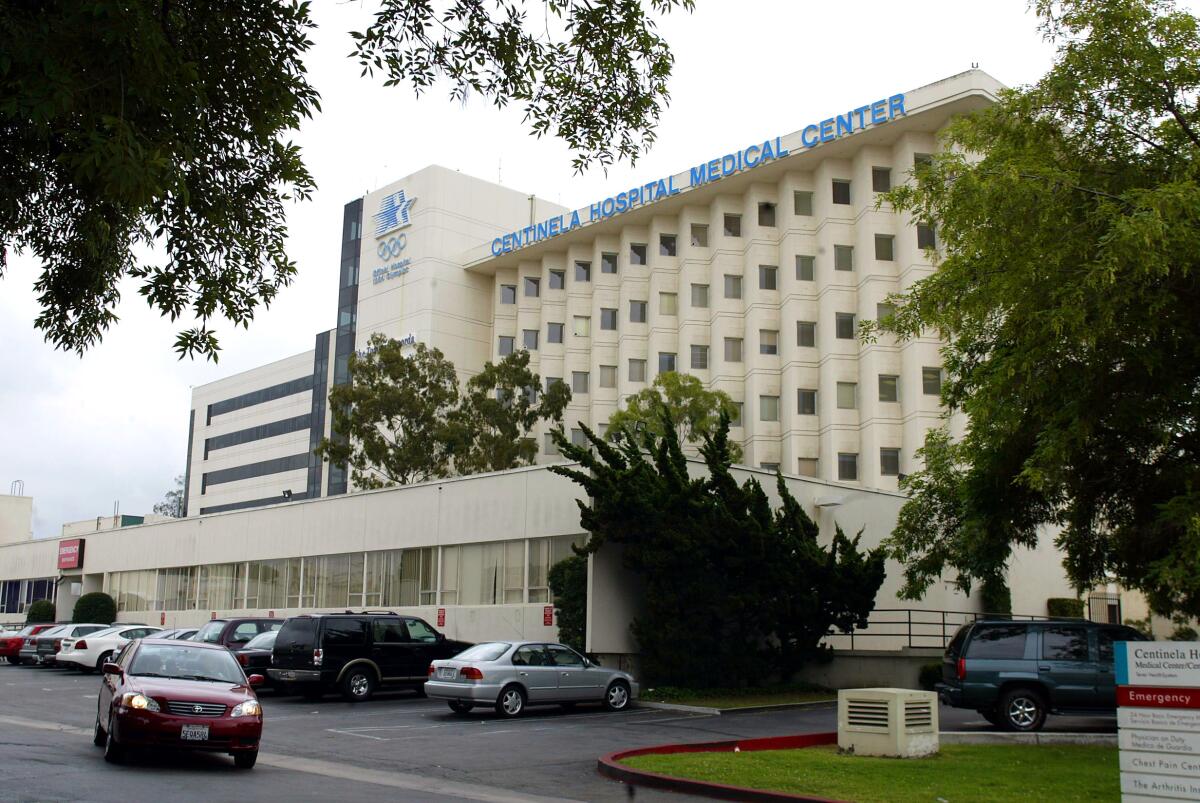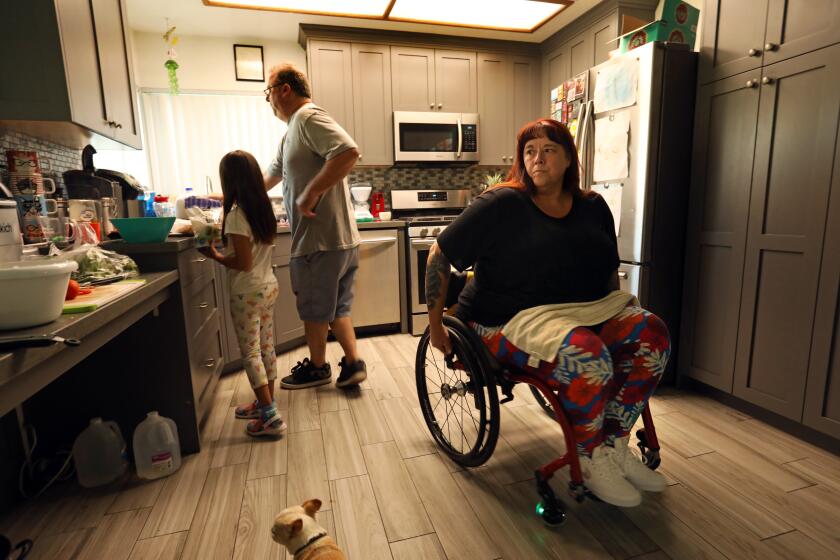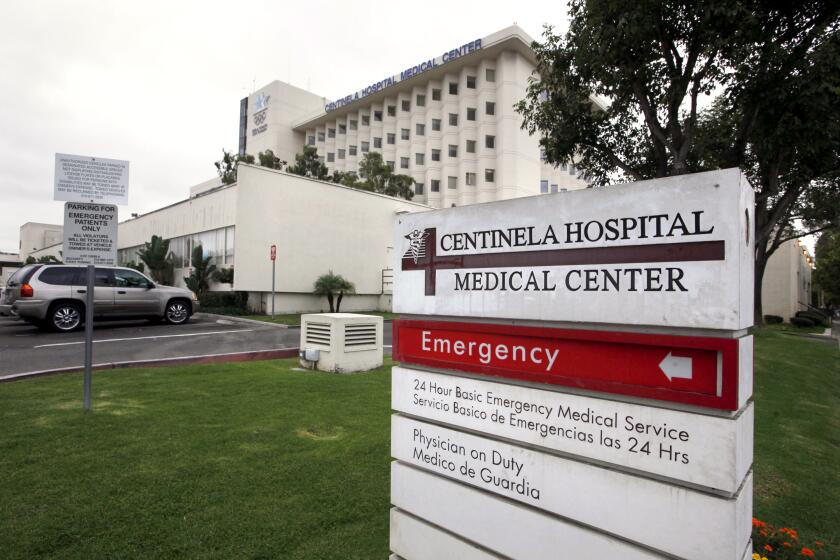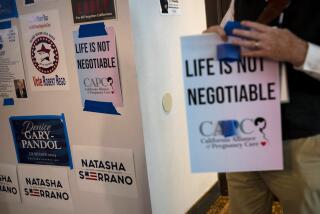Was racism a factor in death at Centinela Hospital? California is ill-equipped to investigate

Aniya was ready to leave. She was dressed in a fuzzy white onesie her mother had packed for her first trip home. Yet Aniya’s family had more questions than answers as they cradled the newborn out of the hospital, her mother’s body left behind.
April Valentine, a 31-year-old Black mother, died while giving birth in Inglewood on Jan. 10. Her family has raised questions of improper care: Why didn’t nurses investigate numbness and swelling in her leg, symptoms she reported at least 10 times over the course of 15 hours? Why did it take nearly 20 hours for her doctor to see her after she arrived at the hospital already in labor?
Valentine’s family wants the state to investigate how she died and whether systemic or interpersonal racism could have played a role. Los Angeles politicians and media have amplified their demands. “I think she would have been treated differently if she was white,” said Valentine’s cousin Mykesha Mack, who filed a complaint.
The official cause of death was a blood clot that formed in her leg and traveled to her lung — a preventable condition. The state has issued a $75,000 fine to Centinela Hospital for risking the health and safety of Valentine, and an inspection report suggests it failed to properly assess her risk for blood clots, take precautions, and alert her physician. Centinela announced last month that it would close its maternity services on Oct. 25.
Even so, the odds of finding discrimination and getting justice remain stacked against her family.
The status of the state’s investigations isn’t clear, and a federal investigation is pending. The hospital and Valentine’s OB-GYN deny allegations of improper care and reject assertions by some family members that Valentine’s care team, which was largely Black, could have harbored bias toward her. But a KFF Health News analysis shows state authorities are ill-equipped to investigate discrimination complaints and often avoid fining hospitals that violate regulations. That highlights a big gap in the state’s ability to hold doctors and hospitals accountable when it comes to reducing bias in maternal care.
Aiming to reduce stark health disparities, in 2019, California became the first state to require implicit bias training for maternity care providers. But the state hasn’t penalized physicians and hospitals that treat patients inequitably, as it hasn’t found discrimination in the incidents brought to its attention. Neither of the agencies overseeing healthcare facilities and physicians — the California Department of Public Health and Medical Board of California — has found discrimination, despite hundreds of complaints going back a decade, the KFF Health News analysis found.
In the unlikely event that regulators find discrimination, they usually prefer corrective actions for violations, such as improvement plans, as opposed to penalties. Karen Smith, a physician who led the Department of Public Health from 2015 to 2019, said the agency wants to push hospitals to provide high-quality care, not to shut them down. So when one violates a regulation, the agency typically tries to help it remedy the problem, depending on the severity. The medical board has come under fire for avoiding meaningful penalties, even for grossly negligent doctors.
California’s rate of maternal deaths is among the lowest in the country, but is up to 3.6 times as high for Black women as for women of other races. Multiple factors, including systemic racism and provider bias, implicit or not, are thought to contribute to this disparity. Valentine’s is not the only high-profile death of a Black mother whose family said her care providers dismissed her.
Some advocates believe these cases keep happening because the state’s oversight of hospitals and doctors is too lax. “There’s no accountability,” said Linda Jones, a co-founder of Black Women Birthing Justice, a nonprofit organization seeking birth equity. “Why should they do anything different?”
Valentine, who worked with at-risk youth and styled hair on the side, was acutely aware of the risks Black mothers face, so she diligently attended prenatal visits and sought a birth doula and Black doctor, her family said.
Valentine’s sister Kesiah Cordova said she accompanied the first-time mother to a late-afternoon visit on Jan. 9 with her OB-GYN, Gwen Allen, who told them Valentine was dilated and that she would meet them at the hospital. Valentine went to Centinela Hospital Medical Center, owned by Prime Healthcare, one of the country’s largest for-profit health systems.
Cordova and Valentine’s partner, Nigha Robertson, were both with her throughout her stay. They said she got to the hospital around 8:30 p.m. While being admitted, Valentine was asked several questions by staff that made her feel uncomfortable, including if she knew who her baby’s father was and what type of housing her baby would live in, they said. Robertson said he doubts white mothers are asked these questions as often. Centinela responded in a statement that every patient is asked these questions to identify any nonmedical factors that could affect their health, so it can provide any necessary resources. Nurses then forbade her doula from attending her delivery, despite the hospital’s approval a month earlier, Robertson and Cordova added. The hospital said it welcomes doulas.
After receiving an epidural five hours later, Valentine reported leg numbness and, later, swelling, they said. Cordova and Robertson estimated that they witnessed Valentine ask nurses to examine her leg and call her doctor at least 10 times. Each time, they said, the nurses declined, saying her symptoms were normal.
“Every time they came to check on her, she would say, ‘Hey, can you look at my leg?’” Cordova said. “The nurse didn’t even lift up the blanket to check.”
Cordova and Robertson said nurses repeatedly told them they couldn’t call Valentine’s OB-GYN because she would get upset. They said Allen did not visit her until 4 p.m. the next day and did not address her concerns.
Two hours later, Cordova and Robertson said, Valentine coughed and vomited. A nurse told them this was normal. Then Valentine stopped breathing. Robertson and Cordova said the nurse in the room froze, so Robertson stepped in and gave Valentine CPR for about five minutes until additional staff, then Allen, arrived. They said her providers did not try to revive her before she was wheeled away. Centinela disputed these allegations but said it could not comment further.
Aniya was delivered via emergency cesarean section from her mother’s body.
The state’s public health department and medical board would not comment on the details of Valentine’s case.
The California Department of Public Health is “deeply saddened” by what happened to Valentine and her family and takes “every action within its legal authority to safeguard patients,” including thoroughly investigating complaints, spokesperson Ali Bay said in a statement.
Asked how it evaluates the possibility of discrimination, the public health department sidestepped and said its role is to determine if any federal or state regulations were violated, and later added that hospitals must follow regulations that allow patients to exercise their rights without regard to race. It provided KFF Health News a copy of a letter dated Feb. 23 from Dr. Mark Ghaly, secretary of the California Health and Human Services Agency, to the Los Angeles County Board of Supervisors. Ghaly declined to be interviewed.
In the letter, he said the state would review medical records, interview medical staff and assess the hospital’s policies and procedures in its investigation.
But the public health department’s track record shows it hasn’t substantiated a discrimination complaint yet. Statewide, the department has not found any violations of regulations protecting patients against discrimination since 2007, Bay said. She said the department found more than 650 complaints that mention racism, discrimination or both in all available records since 2007. It receives an average of about 45,000 total complaints and reported incidents across all facility types every year.
The medical board also hasn’t substantiated discrimination complaints against physicians. Since 2014, it has not found that a physician discriminated against a patient in any of the more than 240 complaints it has closed, said Aaron Bone, the board’s chief of legislation and public affairs. He cautioned against drawing conclusions from a small sample; the agency received approximately 10,000 complaints of all types in 2020 alone.
Serious malpractice leading to the loss of limbs, paralysis and the deaths of patients wasn’t enough for the California Medical Board to stop these bad doctors from continuing to practice medicine.
Both agencies’ figures have limitations. The medical board tracks only discrimination resulting in a doctor’s refusal to treat. And neither agency knows exactly how many discrimination complaints were race-based.
The exact reasons for their limited track records are unclear, but some experts point to the high burden of proof for substantiating these cases.
Abbi Coursolle, a senior attorney at the National Health Law Program, said anti-discrimination laws and regulations can be hard to enforce. They are intended to protect people from intentional discrimination and policies or actions that disproportionately harm them. But people can unconsciously harbor biases, or there could be alternative explanations for ignoring a patient, such as a provider being busy, which can make discrimination hard to substantiate.
Racism “is complicated and hard to isolate, but the law hasn’t quite caught up to that,” she said.
State agencies, she added, can interpret the law so narrowly that people can’t take advantage of these protections.
The California agencies said they do their best within their legal authority. The medical board blamed current law, which, it said, requires “clear and convincing evidence” to discipline a physician, and it can be challenging to substantiate cases if the allegations aren’t documented or aren’t corroborated by witnesses. There may not always be sufficient evidence to find a violation, said Bay, of the public health department.
Smith, the former public health department director, said discrimination by a facility is typically hard to find unless investigators identify a pattern, but that type of research can be labor-intensive and hampered by underreporting of complaints.
So far, the public health department has imposed a $75,000 fine for risking Valentine’s health and safety. In his letter, Ghaly said the state could revoke or suspend the hospital’s license if it finds Centinela violated state or federal regulations. It could also refer the case to other agencies. The federal Department of Health and Human Services’ Office for Civil Rights acknowledged it is investigating Valentine’s case but declined to comment.
Centinela’s fine is the exception, not the rule. Last year, roughly 100 fines were levied against hospitals statewide out of nearly 12,000 complaints and incidents closed, according to a state database. The department cautioned that the data contain many redundant complaints and noted that not all violations require issuance of fines. It declined to provide aggregated data on corrective actions, such as improvement plans, and nonfinancial penalties, such as license suspensions.
Evidence is mixed on whether financial penalties improve hospital care, illustrating how regulators’ hands may be tied.
The state public health department conducted an inspection of Centinela in February. It found the hospital failed to properly assess an unnamed labor and delivery patient’s risk for clotting and failed to notify her physician when she reported “leg heaviness” and when her vital signs were abnormal. Though the inspection, first reported by the Los Angeles Times, does not name Valentine, it describes the account her partner and family shared, including the date she was admitted to the hospital.
In its report, the department deemed the situation “immediate jeopardy,” meaning the hospital’s failure to meet requirements caused or could have caused death or serious injury. But regulators removed that label after the hospital submitted an improvement plan. Among other measures, it promised to reeducate nurses on how to prevent blood clots.
The report found Centinela made similar missteps with other patients, potentially increasing their risk for developing blood clots in deep veins, typically in the leg, which, when untreated, can travel to the lungs. Known as a pulmonary embolism, this condition is one of the most common causes of pregnancy-related deaths in the United States, and is preventable and treatable if discovered early, according to the Centers for Disease Control and Prevention. It was also the official cause of Valentine’s death, stated the Los Angeles County medical examiner’s website.
Centinela said it immediately addressed the inspection’s findings. Sue Lowe, a Centinela spokesperson, said it was the hospital, not the state, that decided to close its maternity and newborn units, “to create capacity for services of greatest benefit and need for patients.”
Centinela Hospital in Inglewood violated federal requirements in ways that could jeopardize patients, including women in labor, a state review found.
Robertson, Valentine’s partner, said he felt the report validated his account.
“They killed her,” said Robertson, who has retained an attorney. For him, justice would mean a punishment severe enough to ensure Valentine’s situation never happens again, but he wants Centinela to remain in business since it’s the only hospital in Inglewood.
Lowe said the hospital could not discuss specifics because of patient privacy laws but extended the hospital’s “thoughts and prayers” to Valentine’s family. She added, “We express our deepest condolences.”
Before the results of the state’s inspection report and the county’s autopsy report were publicized, Centinela implied the death was unpreventable. “Despite the highest standards of care,” Lowe said, “there are certain medically complex and emergent situations that cannot be overcome.” Centinela declined to comment on the autopsy results.
Lowe defended the hospital’s track record, noting it has won national awards for quality and patient safety. She said it had gone a decade without a maternal death in labor and delivery before Valentine’s. She also said the unit was appropriately staffed.
In 2020, the hospital registered 1.8 times the number of complaints and incidents as the state average. So far this year, it’s 9.5 times as many. Lowe responded that the state hasn’t substantiated many of these and that, in some recent years, the hospital had fewer total violations than the state average for hospitals of its size.
The hospital, Lowe said, maintains “robust policies prohibiting discrimination” and requires diversity and implicit bias training for staff. “Our staff reflects the community that we serve,” she added.
Allen, the OB-GYN, directed questions to her attorney, Ludlow B. Creary II, who said his client could not comment on the case, citing patient privacy protections. But he urged against drawing conclusions without both sides of the story and a medical expert’s assessment of whether Allen caused Valentine’s death. Allen, like the community she has served for 20 years, is Black, he added.
Mack, Valentine’s cousin, said Valentine’s providers being largely Black did not sway her view that they could have discriminated against her. She said she hopes the state evaluates whether interpersonal or systemic racism, or both, contributed to Valentine’s death. Did her clinicians dismiss her complaints due to bias, and did the hospital, located in a minority neighborhood, provide lower-quality care?
Both types of racism can be hard to see. The numbers, however, show they exist. Studies suggest Black mothers are more likely than white ones to report being ignored or mistreated by clinicians and to deliver at hospitals with lower-quality care.
The public health department considers how discrimination and systemic racism could have contributed to a maternal death in a quality improvement process known as the California Pregnancy-Associated Mortality Review. But this committee lacks authority to discipline hospitals or clinicians.
Attempts to reform laws often face resistance. Last year, the medical board asked the state to lower the burden of proof for disciplining physicians from “clear and convincing” to a standard equivalent to “more likely than not,” followed by most states. A bill including this request recently passed the California State Senate and is pending in the Assembly.
The California Medical Assn., which represents physicians, opposes the bill, unless amended. “Clear and convincing” is the standard for disciplining professional license holders in California, spokesperson Shannan Velayas said.
In Inglewood, a world away from bureaucrats and lobbyists, Robertson grieves and struggles as a single father. His job in crime scene and disaster cleanup can require long and unpredictable hours. He was recently called in to work at 2 in the morning, leaving him scrambling to get hold of Aniya’s godmother to come watch her.
“It’s overwhelming, just all this juggling,” he said.
In periods of calm, father and daughter bond over picture books Valentine bought and go to the park with their dog. Robertson said Aniya, now over 6 months old and sitting up, is deeply loved. Still, there’s a void that will only grow as Aniya gets older. He can’t style her hair the way Valentine would have and worries that he won’t be able to support her like a mother would when Aniya becomes a young woman.
“I don’t want nobody else to have to go through this hurt and pain,” Robertson said.
When told the state rarely finds discrimination, he paused, recognizing a gap in accountability. He said, “The government picks and chooses which situations that they press the issue on.”
This article was produced by KFF Health News, formerly known as Kaiser Health News, a national newsroom that produces in-depth journalism about health issues.
More to Read
Sign up for Essential California
The most important California stories and recommendations in your inbox every morning.
You may occasionally receive promotional content from the Los Angeles Times.












